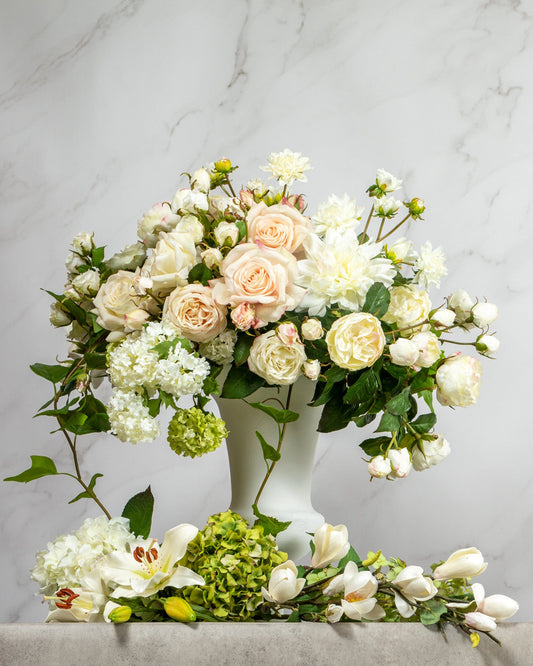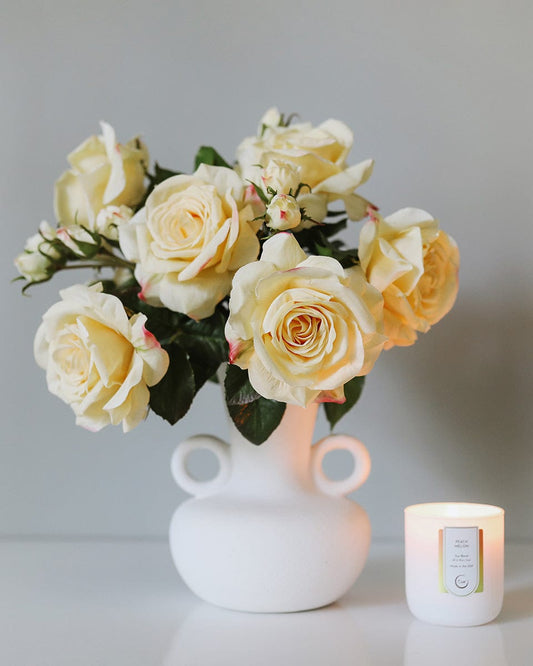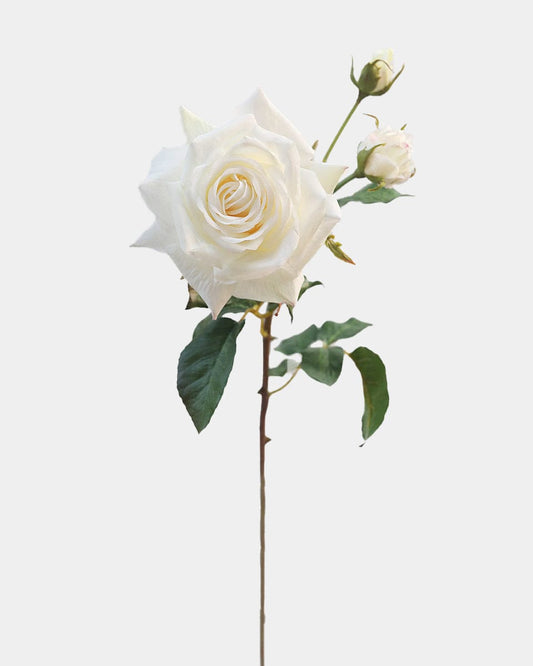Beyond Symmetry: Why Artificial Rose Arrangements Create More Authentic Displays

The late afternoon light caught the silk petals of my latest creation, and I found myself second-guessing the placement for the third time that day. These sunset coral roses—or is it more of a peachy coral? I sometimes debate the exact shade—were arranged in what most would call an "imperfect" grouping.
But standing back, I realized this asymmetrical arrangement captured something that perfectly symmetrical displays never could: the beautiful chaos of how roses actually grow in nature. Artificial roses have evolved far beyond the rigid, obviously fake arrangements of the past.
Key Takeaways
- Asymmetrical arrangements mirror natural rose garden growth patterns
- Strategic imperfection creates more authentic visual appeal than perfect symmetry
- Mixed bloom stages and varied heights enhance realism
- Color gradation techniques add depth and natural variation
- Professional placement creates movement and organic flow
The Authenticity of Asymmetrical Arrangements
When I first started working with artificial roses eighteen years ago, the industry standard was rigid symmetry—every bloom perfectly spaced, every stem precisely the same height. It looked manufactured because, well, it was. But roses in nature don't grow that way, and I've spent years developing techniques that honor their true character.
In my studio, I keep photographs of wild rose hedgerows and English cottage gardens as inspiration. What strikes me most is how roses cluster and cascade naturally—some blooms reaching toward the light, others nestled in protective shadows. This organic irregularity is what I call "gestural quality," and it's become the foundation of my arrangement philosophy.
The Real Touch Prestige Pink Rose captures this philosophy perfectly. Its open bloom structure and subtle color variations make it ideal for creating those naturally imperfect clusters that draw the eye without announcing themselves as artificial.
What strikes me most is how roses cluster and cascade naturally—some blooms reaching toward the light, others nestled in protective shadows. This organic irregularity is what I call "gestural quality," and it's become the foundation of my arrangement philosophy. For those ready to push asymmetry even further, explore brutalist-inspired rose arrangements that celebrate structural tension as a design principle.
I position these roses at varying angles, allowing some to lean slightly forward while others recede into the arrangement. This creates the visual depth that makes viewers forget they're looking at artificial blooms. The key is understanding that authenticity comes from embracing imperfection, not avoiding it.
Creating Movement Through Color and Texture Variation
One breakthrough moment came during a commission for a historical museum when I realized that natural rose gardens never feature uniform coloration. Even within a single variety, you'll find subtle variations—some blooms deeper than others, some catching light differently based on their position and age.
I've developed what I call "color memory layering," where I combine roses in slightly different tones to create the depth you'd find in an actual garden. The Sunset Coral Floribunda Roses work beautifully with deeper coral varieties, creating that natural color progression that occurs when roses bloom at different times.
The spray formation of these floribunda roses adds another layer of authenticity. Unlike single-stem hybrid teas, floribundas naturally produce clusters of blooms, which creates the kind of abundant, cascading effect you see in established rose gardens. I typically use these as anchor points in my arrangements, then fill in with individual stems to create visual rhythm.
What fascinates me about working with multiple bloom stages is how it mirrors the temporal aspect of real roses. In any garden, you'll find tight buds alongside fully opened blooms and everything in between. This variety creates a sense of life and ongoing development that static, uniform arrangements simply can't achieve.
Seasonal Elements and Natural Companions
During my research trips to study heritage roses, I noticed how roses in their natural environment are never isolated—they're surrounded by complementary plants and seasonal elements that enhance their beauty. This observation led me to incorporate elements like rose hips into my faux roses arrangements, adding both textural interest and botanical accuracy.
The Artificial Rose Hip Berries in burgundy bring an authentic autumn element that many people don't expect in rose arrangements. But rose hips are the natural fruit of roses, and including them creates a more complete botanical story.
I've found that adding rose hips creates visual weight at the base of arrangements while introducing a rich, wine-colored accent that complements both pink and coral roses beautifully. The key is using them sparingly—just a few stems positioned asymmetrically to suggest the natural randomness of fruit development.
This approach acknowledges that roses exist within a larger ecosystem. In my arrangements, I'm not just recreating individual flowers—I'm capturing the essence of the rose's complete life cycle and natural habitat. Discover more ways to celebrate roses year-round with seasonal display ideas for National Rose Month and beyond.
Professional Techniques for Authentic Display
After years of perfecting these methods, I've developed a systematic approach to creating arrangements that feel genuinely organic. The secret lies in what I call "intentional randomness"—carefully planned asymmetry that appears completely natural.
I start by establishing three height levels within each arrangement, typically varying by 3-4 inches between levels. The tallest stems create the backbone, medium-height blooms fill the visual middle, and shorter elements provide weight and stability. But here's what most people miss: the positioning isn't random at all. I use the golden ratio to determine placement points, then deliberately offset them slightly to avoid mathematical precision.
The Faux White Rose Centerpiece demonstrates this principle perfectly in a more formal setting. Even in a structured glass vessel, the arrangement maintains organic flow through varied stem angles and natural bloom positioning. These realistic artificial roses prove that authenticity comes from understanding natural principles rather than copying them exactly.
The beauty of this centerpiece lies in how it balances formality with natural grace. The roses appear to have settled into their positions organically, yet the overall composition maintains elegant structure. This is achieved through careful attention to negative space—the gaps between blooms that allow each flower to breathe and catch light individually.
What I've learned is that authenticity in artificial rose arrangements comes not from copying nature exactly, but from understanding and interpreting its underlying principles. When we embrace asymmetry, variation, and the beautiful imperfections that make real roses so captivating, our artificial arrangements transcend their medium and become something truly special.
Bringing Natural Beauty Into Your Space
Creating authentic-looking artificial rose arrangements isn't about following rigid rules—it's about understanding how roses naturally behave and translating that knowledge into your own space. The techniques I've shared here have evolved from years of studying both botanical accuracy and human perception, but the real magic happens when you start trusting your instincts about what looks natural.
Remember that asymmetry doesn't mean chaos. It means thoughtful irregularity that honors how roses actually grow and bloom in nature. Whether you're working with a single variety or creating complex multi-tonal arrangements, the principle remains the same: best artificial roses shine brightest when they're allowed to express their natural character rather than being forced into artificial perfection.
Whether you're working with a single variety or creating complex multi-tonal arrangements, the principle remains the same: roses shine brightest when allowed to express their natural character. Browse our curated collection of realistic artificial roses to find the perfect varieties for your asymmetrical arrangement experiments.
Frequently Asked Questions
How many roses should I use in an asymmetrical arrangement?
I typically work with odd numbers—3, 5, or 7 stems depending on the vessel size. Odd numbers create more natural-looking groupings and prevent the eye from automatically seeking symmetrical balance. For larger arrangements, I'll use 9-11 stems arranged in asymmetrical clusters.
What's the best way to vary heights in a rose arrangement?
Create three distinct height levels with 2-3 inch differences between each level. The tallest stems should be about 1.5 times the height of your vessel, with medium stems at about 1.2 times vessel height, and shorter stems just above the rim. This creates natural-looking depth without appearing too structured.
Can I mix different types of artificial roses in one arrangement?
Absolutely! Mixing varieties like hybrid teas with floribunda sprays or garden roses creates the kind of diversity you'd find in an actual rose garden. Just ensure the colors work harmoniously together—I often use roses in the same color family but different intensities or combine complementary tones like coral and burgundy.
How do I prevent my asymmetrical arrangement from looking messy?
The key is maintaining visual balance even within asymmetry. Distribute visual weight evenly by placing larger blooms or darker colors strategically throughout the arrangement rather than clustering them all on one side. Think of it as creating a triangle of focal points that keeps the eye engaged without overwhelming the composition.


















